Using Ground-Penetrating Radar and Deep Learning to Rapidly Detect Voids and Rebar Defects in Linings
Abstract
1. Introduction
2. Methodology
2.1. GPR Principle
2.2. Detection Method
2.3. SSD
2.4. YOLOv4
2.5. Non-Maximum Suppression
2.6. Transfer Learning
3. Real Dataset for Deep Learning
3.1. Collection of Real Radar Data on Site
3.2. Lining Detection Model Test
3.2.1. Design and Establishment of Lining Model
3.2.2. Acquisition of Ground Radar Signals
3.2.3. Radar Image Features of Typical Quality Defects
- Lining void
- Steel bar loss
3.3. Processing of Data
4. Results and Discussions
4.1. Analysis of Prediction Effect of Tunnel Defect Identification Model
4.2. Accuracy Analysis of Tunnel Defect Recognition Model
4.3. Comprehensive Performance Analysis of Tunnel Defect Recognition Model
5. Conclusions
Author Contributions
Funding
Institutional Review Board Statement
Informed Consent Statement
Data Availability Statement
Conflicts of Interest
Abbreviations
| GPR | Ground-penetrating radar |
| SSD | Single Shot MultiBox Detector |
| YOLO | You Only Look Once |
| AP | Average Precision |
| mAP | Mean Average Precision |
| FDTD | Finite-difference Time-domain |
References
- Hong, K.; Feng, H. Development Trends and Views of Highway Tunnels in China over the Past Decade. China J. Highw. Transp. 2020, 33, 62–76. [Google Scholar]
- Lu, F.; Wang, Y.; Fu, J.; Yang, Y.; Qiu, W.; Jing, Y.; Jiang, M.; Li, H. Safety Evaluation of Plain Concrete Lining Considering Deterioration and Aerodynamic Effects. Sustainability 2023, 15, 7170. [Google Scholar] [CrossRef]
- Popovics, S.; Rose, J.L.; Popovics, J.S. The behaviour of ultrasonic pulses in concrete. Cem. Concr. Res. 1990, 20, 259–270. [Google Scholar] [CrossRef]
- Le Sant, Y.; Marchand, M.; Millan, P.; Fontaine, J. An overview of infrared thermography techniques used in large wind tunnels. Aerosp. Sci. Technol. 2002, 6, 355–366. [Google Scholar] [CrossRef]
- Li, S.; Zhou, Z.; Ye, Z.; Li, L.; Zhang, Q.; Xu, Z. Comprehensive geophysical prediction and treatment measures of karst caves in deep buried tunnel. J. Appl. Geophys. 2015, 116, 247–257. [Google Scholar] [CrossRef]
- Liu, M.; Liu, Z.; Zhou, D.; Lan, R.; Wu, H. Recognition method of typical anomalies during karst tunnel construction using GPR attributes and Gaussian processes. Arab. J. Geosci. 2020, 13, 1–13. [Google Scholar] [CrossRef]
- Liu, Z.; Wu, Y.; Liu, B.; Liu, M.; Lan, R.; Sun, H. Research on the interference elimination method of GPR signal for tunnel geological prediction. Chin. J. Eng. 2020, 42, 390–398. [Google Scholar]
- Liu, B.; Zhang, F.; Li, S.; Li, Y.; Xu, S.; Nie, L.; Zhang, C.; Zhang, Q. Forward modelling and imaging of ground-penetrating radar in tunnel ahead geological prospecting. Geophys. Prospect. 2018, 66, 784–797. [Google Scholar] [CrossRef]
- Luo, G.; Cao, Y.; Xu, H.; Yang, G.; Wang, S.; Huang, Y.; Bai, Z. Research on typical soil physical properties in a mining area: Feasibility of three-dimensional ground penetrating radar detection. Environ. Earth Sci. 2021, 80, 1–11. [Google Scholar] [CrossRef]
- Zheng, A.; Zhao, H.; Tan, B.; Huang, F.; He, Z. Radar Image Recognition of Tunnel Lining Cavity Fillings Based on SVM. Mod. Tunn. Technol. 2022, 59, 45–52. [Google Scholar]
- Liu, H.; Deng, Z.; Han, F.; Xia, Y.; Liu, Q.H.; Sato, M. Time-frequency analysis of air-coupled GPR data for identification of delamination between pavement layers. Constr. Build. Mater. 2017, 154, 1207–1215. [Google Scholar] [CrossRef]
- Benedetto, A.; Tosti, F.; Ciampoli, L.B.; D’amico, F. An overview of ground-penetrating radar signal processing techniques for road inspections. Signal Process. 2017, 132, 201–209. [Google Scholar] [CrossRef]
- Li, W.; Cui, X.; Guo, L.; Chen, J.; Chen, X.; Cao, X. Tree root automatic recognition in ground penetrating radar profiles based on randomized Hough transform. Remote Sens. 2016, 8, 430. [Google Scholar] [CrossRef]
- Zhixin, Z.; Shuhao, J. Design of incomplete 3D information image recognition system based on SIFT algorithm and wireless network. EURASIP J. Wirel. Commun. Netw. 2020, 2020, 1–20. [Google Scholar] [CrossRef]
- Xie, X.; Li, P.; Qin, H.; Liu, L.; Nobes, D.C. GPR identification of voids inside concrete based on the support vector machine algorithm. J. Geophys. Eng. 2013, 10, 034002. [Google Scholar] [CrossRef]
- Long, J.; Shelhamer, E.; Darrell, T. Fully Convolutional Networks for Semantic Segmentation. In Proceedings of the IEEE Conference on Computer Vision and Pattern Recognition, Boston, MA, USA, 7–12 June 2015; Volume 2015, pp. 3431–3440. [Google Scholar]
- Ronneberger, O.; Fischer, P.; Brox, T. U-Net: Convolutional Networks for Biomedical Image Segmentation. In Proceedings of the Medical Image Computing and Computer-Assisted Intervention–MICCAI 2015: 18th International Conference, Munich, Germany, 5–9 October 2015; Springer: Berlin/Heidelberg, Germany, 2015; pp. 234–241. [Google Scholar]
- Badrinarayanan, V.; Kendall, A.; Cipolla, R. Segnet: A deep convolutional encoder-decoder architecture for image segmentation. IEEE Trans. Pattern Anal. Mach. Intell. 2017, 39, 2481–2495. [Google Scholar] [CrossRef]
- Xu, Y.; Mo, T.; Feng, Q.; Zhong, P.; Lai, M.; Eric, I.; Chang, C. Deep Learning of Feature Representation with Multiple Instance Learning for Medical Image Analysis. In Proceedings of the 2014 IEEE International Conference on Acoustics, Speech and Signal Processing (ICASSP), Florence, Italy, 4–9 May 2014; pp. 1626–1630. [Google Scholar]
- Kayalibay, B.; Jensen, G.; van der Smagt, P. CNN-based segmentation of medical imaging data. arXiv 2017, arXiv:1701.03056. [Google Scholar]
- Li, S.; Liu, B.; Ren, Y.; Chen, Y.; Yang, S.; Wang, Y.; Jiang, P. Deep-learning inversion of seismic data. arXiv 2019, arXiv:1901.07733. [Google Scholar] [CrossRef]
- Liu, B.; Guo, Q.; Li, S.; Liu, B.; Ren, Y.; Pang, Y.; Guo, X.; Liu, L.; Jiang, P. Deep learning inversion of electrical resistivity data. IEEE Trans. Geosci. Remote Sens. 2020, 58, 5715–5728. [Google Scholar] [CrossRef]
- Huang, H.-W.; Li, Q.-T.; Zhang, D.-M. Deep learning based image recognition for crack and leakage defects of metro shield tunnel. Tunn. Undergr. Space Technol. 2018, 77, 166–176. [Google Scholar] [CrossRef]
- Ren, Y.; Huang, J.; Hong, Z.; Lu, W.; Yin, J.; Zou, L.; Shen, X. Image-based concrete crack detection in tunnels using deep fully convolutional networks. Constr. Build. Mater. 2020, 234, 117367. [Google Scholar] [CrossRef]
- Yang, S.; Wang, Z.; Wang, J.; Cohn, A.G.; Zhang, J.; Jiang, P.; Nie, L.; Sui, Q. Defect segmentation: Mapping tunnel lining internal defects with ground penetrating radar data using a convolutional neural network. Constr. Build. Mater. 2022, 319, 125658. [Google Scholar]
- Qin, H.; Zhang, D.; Tang, Y.; Wang, Y. Automatic recognition of tunnel lining elements from GPR images using deep convolutional networks with data augmentation. Autom. Constr. 2021, 130, 103830. [Google Scholar] [CrossRef]
- Ye, Z.; Ye, Y. Comparison of Detection Effect of Cavities Behind Shield Tunnel Segment Using Transient Electromagnetic Radar and Ground Penetration Radar. Geotech. Geol. Eng. 2019, 37, 4391–4403. [Google Scholar] [CrossRef]
- Liu, W.; Anguelov, D.; Erhan, D.; Szegedy, C.; Reed, S.; Fu, C.-Y.; Berg, A.C. Ssd: Single Shot Multibox Detector. In Proceedings of the Computer Vision–ECCV 2016: 14th European Conference, Amsterdam, The Netherlands, 11–14 October 2016; Springer: Berlin/Heidelberg, Germany, 2016; pp. 21–37. [Google Scholar]
- Simonyan, K.; Zisserman, A. Very deep convolutional networks for large-scale image recognition. arXiv 2014, arXiv:1409.1556. [Google Scholar]
- Bochkovskiy, A.; Wang, C.-Y.; Liao, H.-Y.M. Yolov4: Optimal speed and accuracy of object detection. arXiv 2020, arXiv:2004.10934. [Google Scholar]
- Zhong, B. Study on the Damage Characteristics and Service Status Evaluation Methods of Highway Tunnel Lining in Yunnan Mountain Area; University of Science and Technology: Kunming, China, 2018. [Google Scholar]

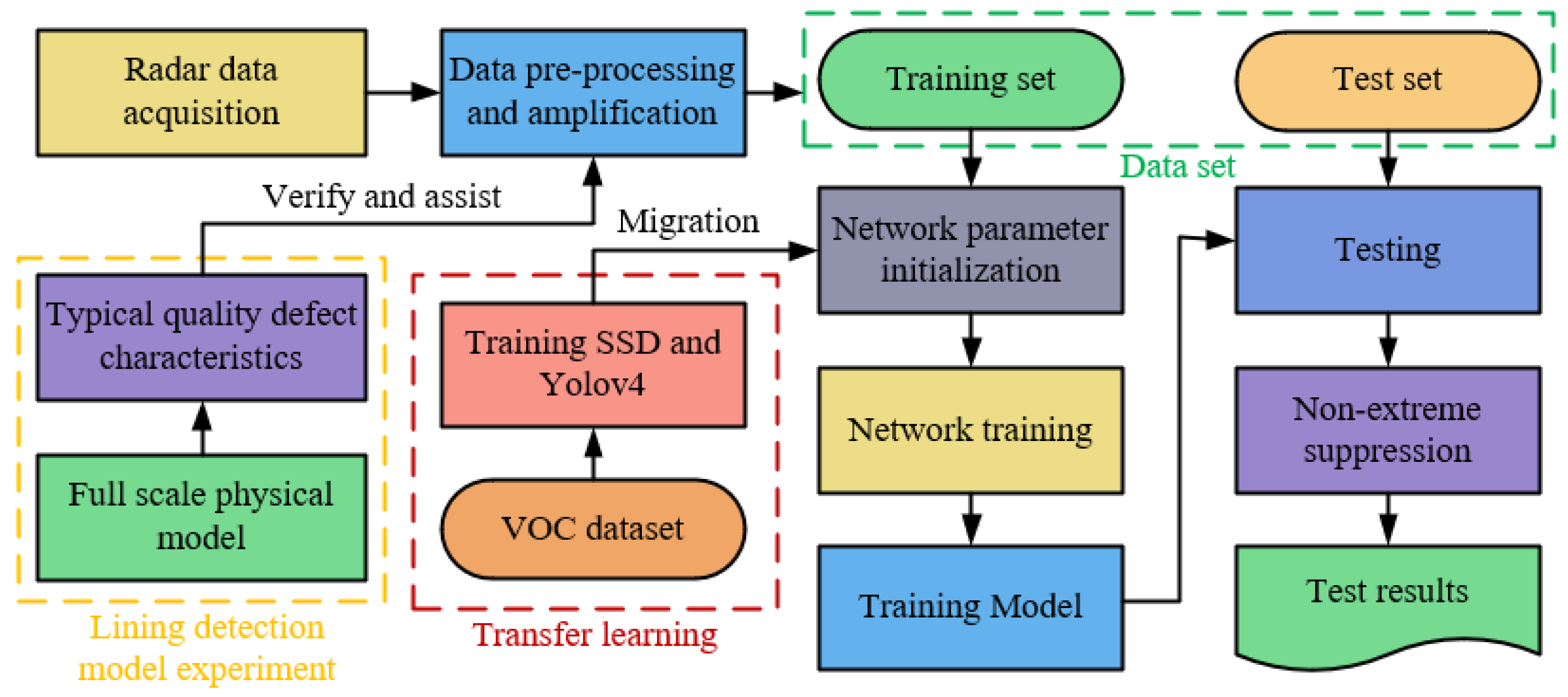




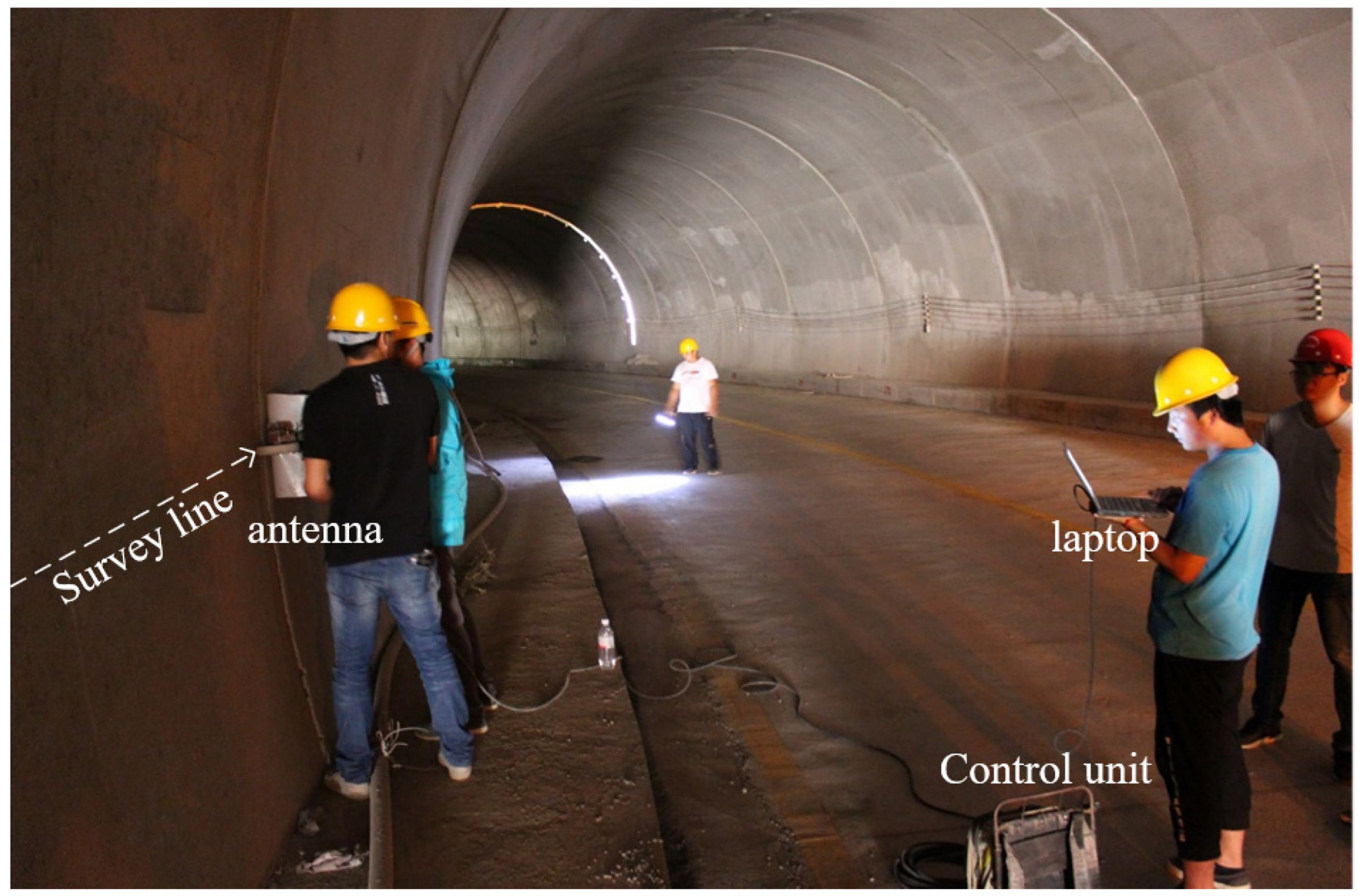
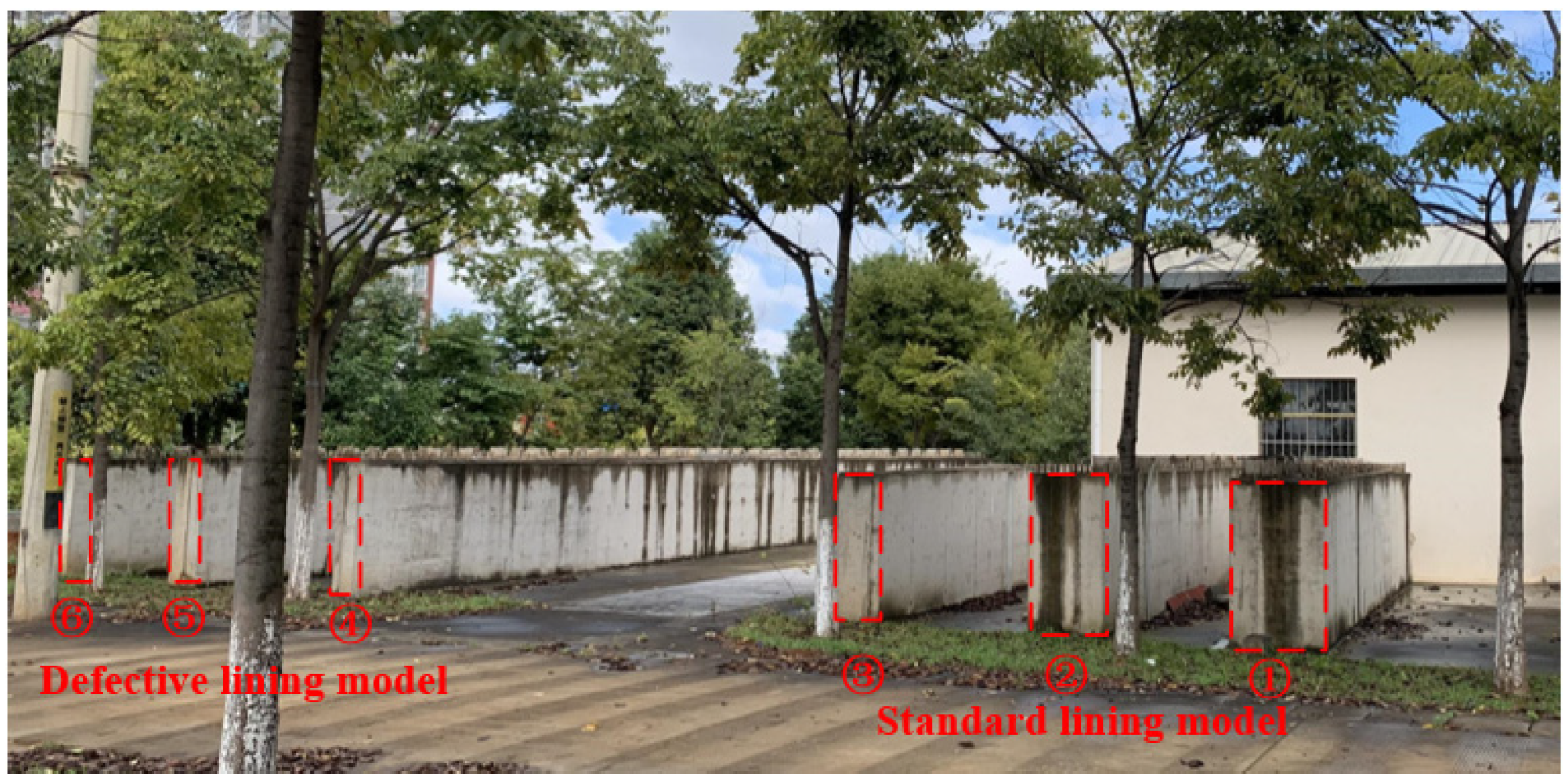
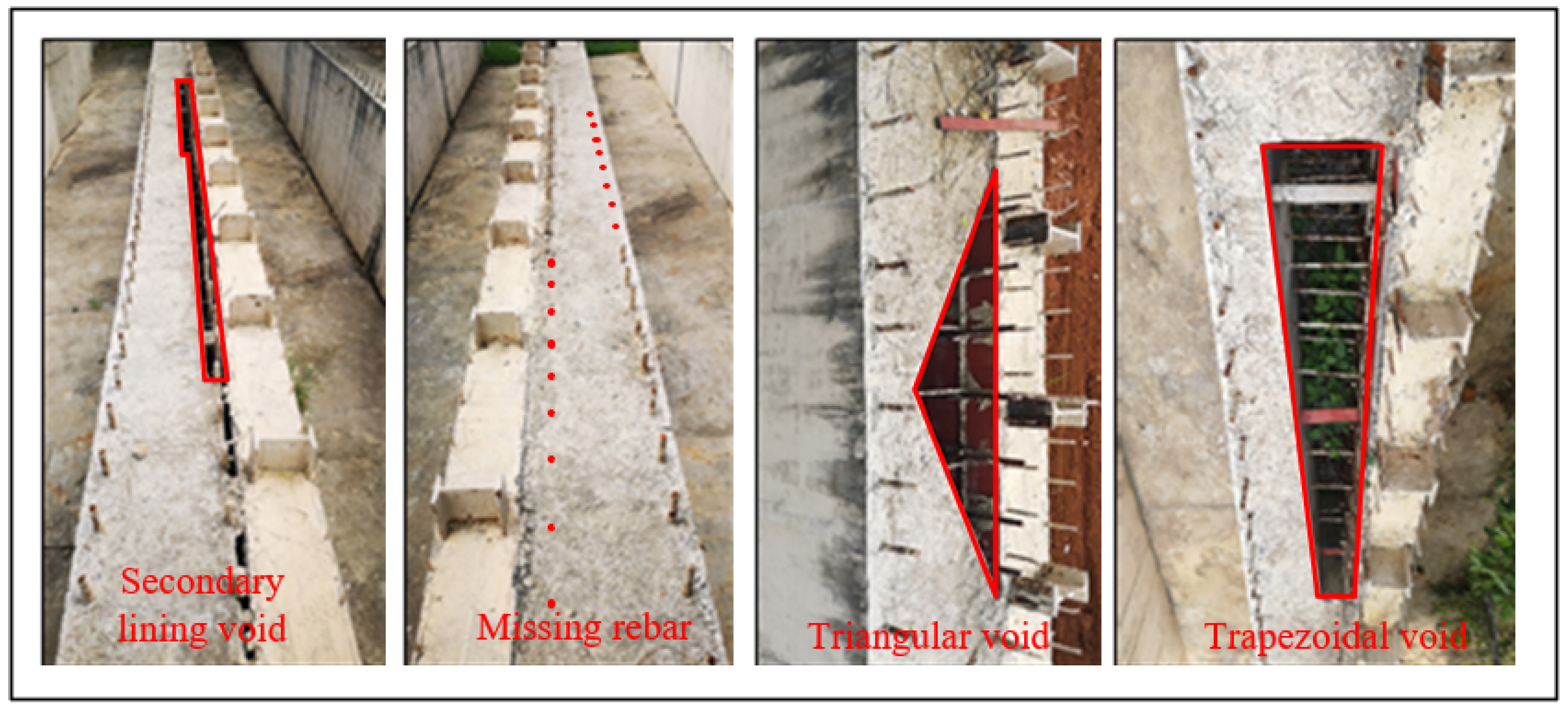
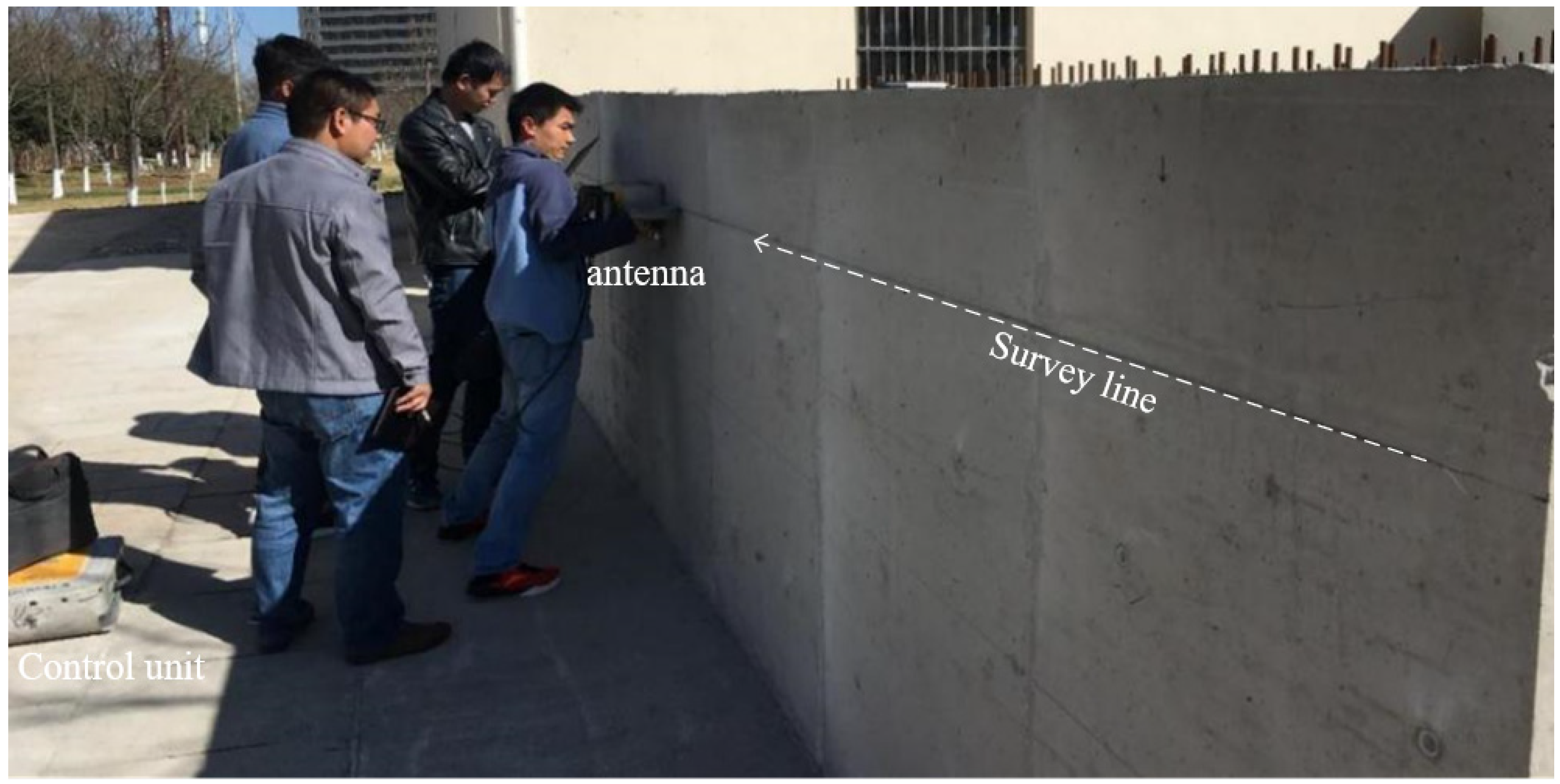



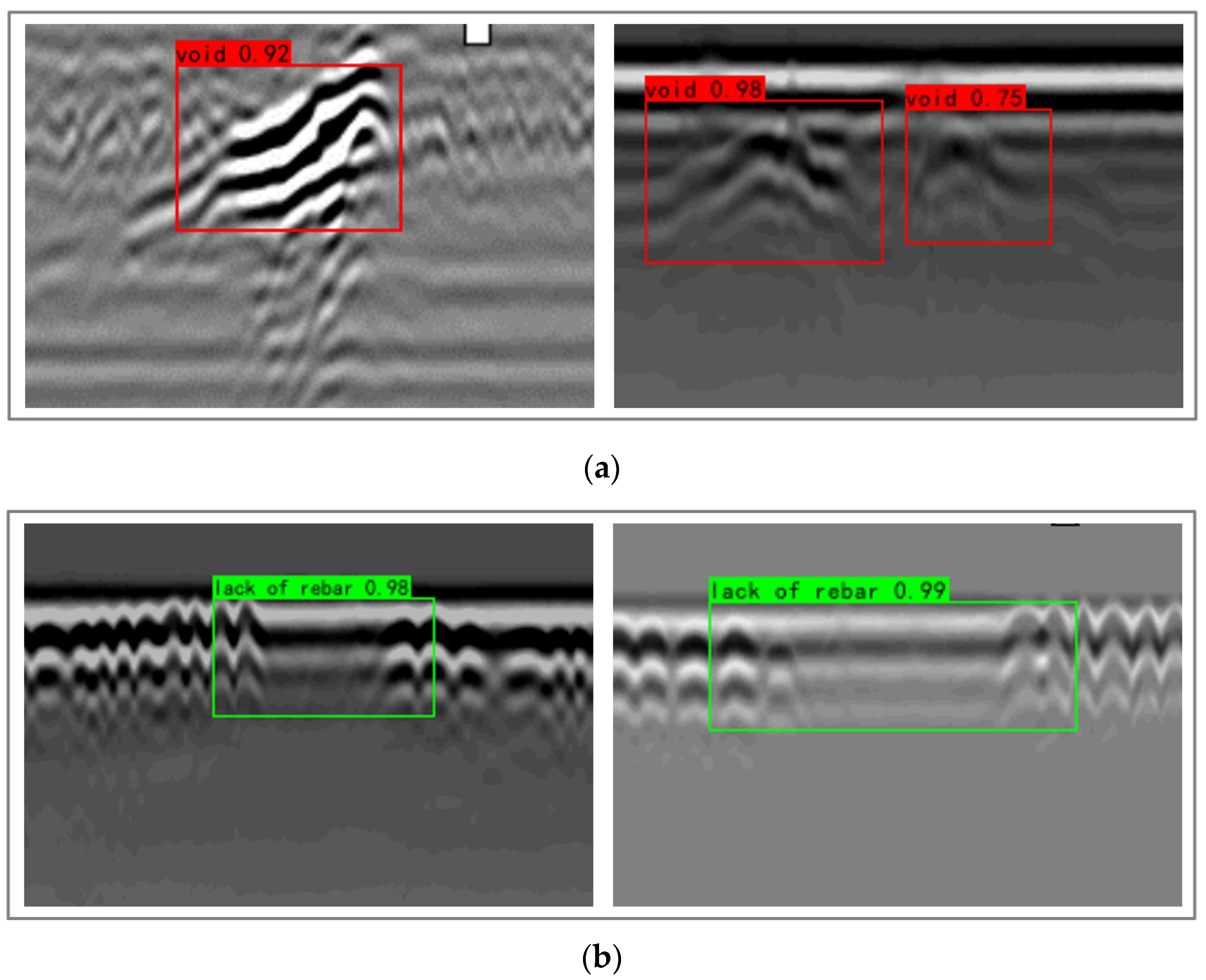
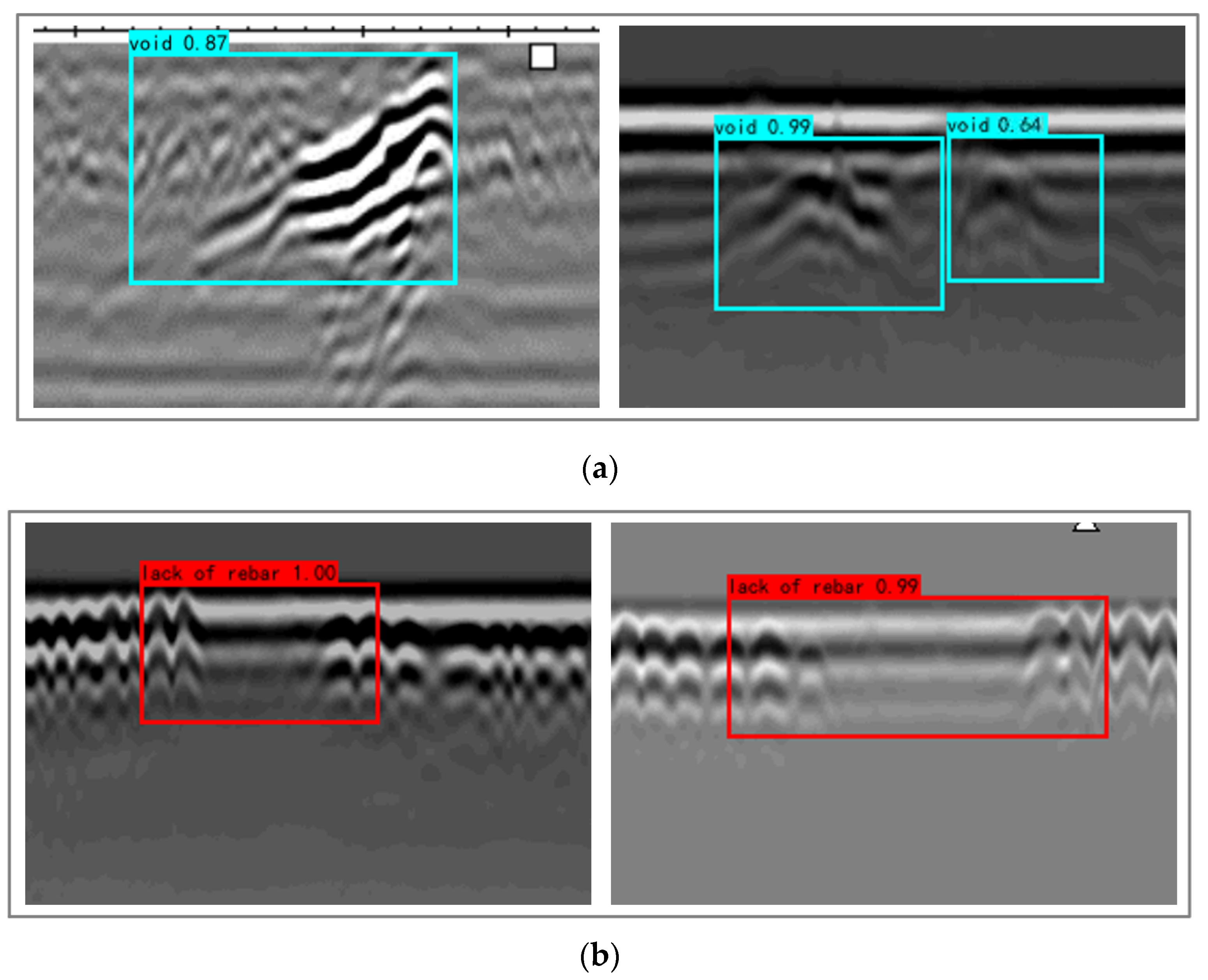
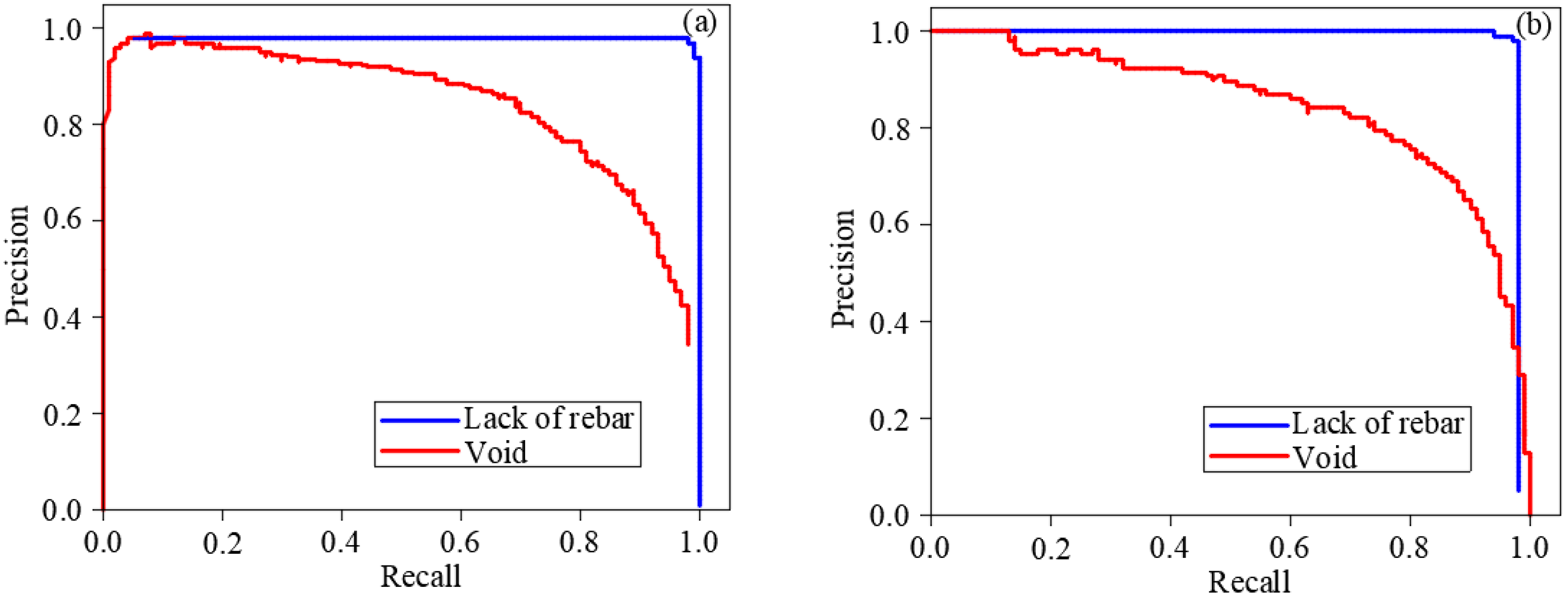

| GPR System | Antenna Center Frequency (MHz) | Sampling Frequency (MHz) | Samples per Scan | Time Window (ns) | Sampling Interval (cm) | Trigger Mode |
|---|---|---|---|---|---|---|
| MALA (X3M) | 500 | 7500 | 512 | 50 | 2 | Distance-based |
| Model | mAP (%) | Size (MB) | Time (h) | Rate (FPS) |
|---|---|---|---|---|
| SSD | 92.14 | 93 | 23.5 | 36.84 |
| YOLOv4 | 92.12 | 246 | 8 | 70.52 |
Disclaimer/Publisher’s Note: The statements, opinions and data contained in all publications are solely those of the individual author(s) and contributor(s) and not of MDPI and/or the editor(s). MDPI and/or the editor(s) disclaim responsibility for any injury to people or property resulting from any ideas, methods, instructions or products referred to in the content. |
© 2023 by the authors. Licensee MDPI, Basel, Switzerland. This article is an open access article distributed under the terms and conditions of the Creative Commons Attribution (CC BY) license (https://creativecommons.org/licenses/by/4.0/).
Share and Cite
Liu, P.; Ding, Z.; Zhang, W.; Ren, Z.; Yang, X. Using Ground-Penetrating Radar and Deep Learning to Rapidly Detect Voids and Rebar Defects in Linings. Sustainability 2023, 15, 11855. https://doi.org/10.3390/su151511855
Liu P, Ding Z, Zhang W, Ren Z, Yang X. Using Ground-Penetrating Radar and Deep Learning to Rapidly Detect Voids and Rebar Defects in Linings. Sustainability. 2023; 15(15):11855. https://doi.org/10.3390/su151511855
Chicago/Turabian StyleLiu, Peng, Zude Ding, Wanping Zhang, Zhihua Ren, and Xuxiang Yang. 2023. "Using Ground-Penetrating Radar and Deep Learning to Rapidly Detect Voids and Rebar Defects in Linings" Sustainability 15, no. 15: 11855. https://doi.org/10.3390/su151511855
APA StyleLiu, P., Ding, Z., Zhang, W., Ren, Z., & Yang, X. (2023). Using Ground-Penetrating Radar and Deep Learning to Rapidly Detect Voids and Rebar Defects in Linings. Sustainability, 15(15), 11855. https://doi.org/10.3390/su151511855





